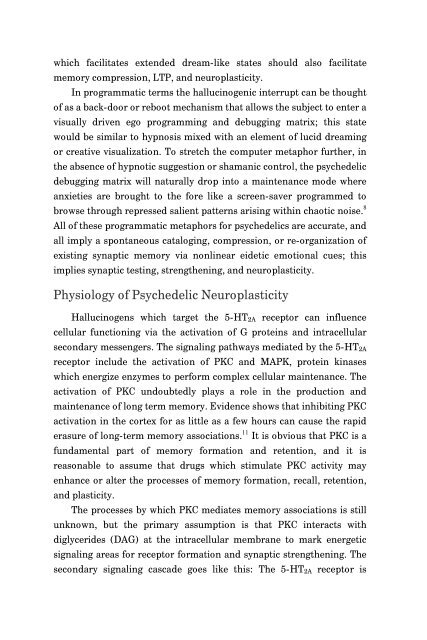Psychedelic-information-theory-Shamanism-in-the-age-of-Reason
Psychedelic-information-theory-Shamanism-in-the-age-of-Reason
Psychedelic-information-theory-Shamanism-in-the-age-of-Reason
- No tags were found...
Create successful ePaper yourself
Turn your PDF publications into a flip-book with our unique Google optimized e-Paper software.
which facilitates extended dream-like states should also facilitatememory compression, LTP, and neuroplasticity.In programmatic terms <strong>the</strong> halluc<strong>in</strong>ogenic <strong>in</strong>terrupt can be thought<strong>of</strong> as a back-door or reboot mechanism that allows <strong>the</strong> subject to enter avisually driven ego programm<strong>in</strong>g and debugg<strong>in</strong>g matrix; this statewould be similar to hypnosis mixed with an element <strong>of</strong> lucid dream<strong>in</strong>gor creative visualization. To stretch <strong>the</strong> computer metaphor fur<strong>the</strong>r, <strong>in</strong><strong>the</strong> absence <strong>of</strong> hypnotic suggestion or shamanic control, <strong>the</strong> psychedelicdebugg<strong>in</strong>g matrix will naturally drop <strong>in</strong>to a ma<strong>in</strong>tenance mode whereanxieties are brought to <strong>the</strong> fore like a screen-saver programmed tobrowse through repressed salient patterns aris<strong>in</strong>g with<strong>in</strong> chaotic noise. 8All <strong>of</strong> <strong>the</strong>se programmatic metaphors for psychedelics are accurate, andall imply a spontaneous catalog<strong>in</strong>g, compression, or re-organization <strong>of</strong>exist<strong>in</strong>g synaptic memory via nonl<strong>in</strong>ear eidetic emotional cues; thisimplies synaptic test<strong>in</strong>g, streng<strong>the</strong>n<strong>in</strong>g, and neuroplasticity.Physiology <strong>of</strong> <strong>Psychedelic</strong> NeuroplasticityHalluc<strong>in</strong>ogens which target <strong>the</strong> 5-HT 2A receptor can <strong>in</strong>fluencecellular function<strong>in</strong>g via <strong>the</strong> activation <strong>of</strong> G prote<strong>in</strong>s and <strong>in</strong>tracellularsecondary messengers. The signal<strong>in</strong>g pathways mediated by <strong>the</strong> 5-HT 2Areceptor <strong>in</strong>clude <strong>the</strong> activation <strong>of</strong> PKC and MAPK, prote<strong>in</strong> k<strong>in</strong>aseswhich energize enzymes to perform complex cellular ma<strong>in</strong>tenance. Theactivation <strong>of</strong> PKC undoubtedly plays a role <strong>in</strong> <strong>the</strong> production andma<strong>in</strong>tenance <strong>of</strong> long term memory. Evidence shows that <strong>in</strong>hibit<strong>in</strong>g PKCactivation <strong>in</strong> <strong>the</strong> cortex for as little as a few hours can cause <strong>the</strong> rapiderasure <strong>of</strong> long-term memory associations. 11 It is obvious that PKC is afundamental part <strong>of</strong> memory formation and retention, and it isreasonable to assume that drugs which stimulate PKC activity mayenhance or alter <strong>the</strong> processes <strong>of</strong> memory formation, recall, retention,and plasticity.The processes by which PKC mediates memory associations is stillunknown, but <strong>the</strong> primary assumption is that PKC <strong>in</strong>teracts withdiglycerides (DAG) at <strong>the</strong> <strong>in</strong>tracellular membrane to mark energeticsignal<strong>in</strong>g areas for receptor formation and synaptic streng<strong>the</strong>n<strong>in</strong>g. Thesecondary signal<strong>in</strong>g cascade goes like this: The 5-HT 2A receptor is


